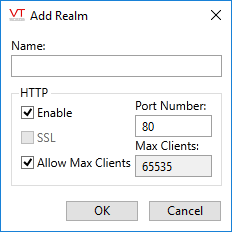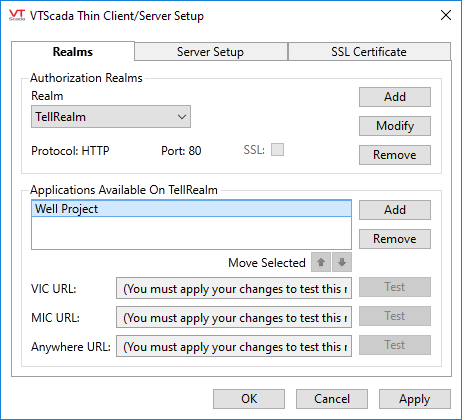
If exposing diagnostic applications to the Internet you are advised to take all possible precautions to prevent their use by unauthorized persons.
Do not name any realm, "Rest" or "SQLQuery". Doing so will interfere with remote access to VTScada data.
To provide access to an application, you must associate it with a Realm name.
- Open the Internet Setup dialog, from the VAM
 VTScada Application Manager.
VTScada Application Manager. - Ensure that the Realms tab is selected.
- Click Add in the Authorization Realms section of the dialog.

- Enter a meaningful name for the realm in the Realm Name field.
Realm names should not include spaces. Use a hyphen, underscore or mixed case to indicate word boundaries (e.g. "My-Realm", "My_Realm" or "MyRealm" ).
- Enable the HTTP protocol.
- Enter the port number, to which the client should connect to authenticate.
(See notes in the preceding topic, Internet Realms)
- Click OK.
The new realm is created, and you are returned to the VTScada Thin Client/Server Setup dialog where the new realm appears in the Realm drop-down list. This will look similar to the following example:

- Click Add in the Applications Available On section of the VTScada Thin Client/Server Setup dialog.
The Add Application dialog opens as shown.

- Select the VTScada application you wish to add to this realm from the Application drop-down list.
The first VTScada application added to this realm is the default application for the realm. A connection is automatically attempted to the default application if a partially specified URL is provided to your web browser. For example:
http://myserver.trihedral.com/myrealm
is a partially specified URL, containing only the protocol (http), host (myserver), domain name (trihedral.com), and realm (myrealm).
- Click OK.
You are returned to the VTScada Thin Client/Server Setup dialog where the selected application has been added to the realm.
- Repeat steps 8 through 10 to add as many VTScada applications (both standard and script applications) as you wish for this realm.
- Click OK.
Your application is now available to VTScada Thin Clients.
Test
Having successfully configured a VTScada Thin Client Server, and a Realm, you can test your work directly from the Realm configuration dialog.
It must be possible to create a local connection to the VTScada Thin Client Server to test using this dialog. If the "Local" box option is not selected in the Server Setup page of this dialog, you should review your Name Resolution service. If there is no network connection, this might be done by editing the HOSTS file in your C:\Windows\System32\Drv\ folder to configure the IP address for your computer name. Also, the application must be running.
Removes the selected realm (and the list of applications attached to it) from the list.
You will be prompted to confirm this action before the realm is removed. (If removing an application from the realm, there is no prompt.)

In the case that you have more than one Thin Client Server, the realm will be removed from all. Any users who are connected to the realm will be disconnected immediately.
Troubleshooting:
- Unable to connect.
Check that no other service is using the configured port.
If trying to connect using the server computer, check that the Local option has been selected (done automatically). If not, it is likely that the domain is not being recognized.
If trying to connect remotely, check that the server is visible on the network. Firewall or proxy server configuration may be required.
Check that the VTScada Thin Client Server configuration has been completed correctly.
Check that security has been enabled in the application, and that your account has the Thin Client Access privilege.
